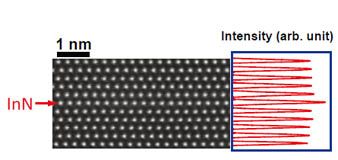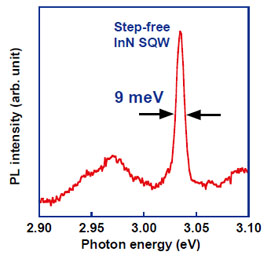from Ultrathin InN Single Quantum Well on Step-Free GaN Surface
Materials Science Laboratory, *Optical Science Laboratory
Blue and green light emitting diodes (LEDs) have been
achieved with InGaN quantum well (QW) active layers.For a longer wavelength
emission, e.g., red emission, InGaN QWs havingmuch higher In composition
arerequired, butthe higher In concentrationcausessevere deterioration of
crystalline quality. High-efficiency emission in near-ultraviolet, visible,
and near-infrared regions, in principle,can also be achieved by using InN
QWs, if the thickness of the ultrathin InN QWs [typically several monolayers
(MLs)] can be controlled with an accuracy of a single ML. However, abrupt
hetero-interfaces without a single-ML step have not been obtained so far.
Recently, we have succeeded in fabricating step-free GaN surfaces 50 µm
in diameter without any ML steps by selective-area metalorganic vapor phase
epitaxy [1]. In the present study, we investigated the fabrication of step-free
InN QWs using step-free GaN surfaces as a template.
Partially coalesced two-dimensional nuclei of InN were formed on a step-free GaN surface by a 10-s InN growth. The coalescence was completed after 30 s and 1-ML-thick step-free InN was eventually formed. Subsequently, a step-free InN single quantum well (SQW) hetero-structure was fabricated by depositing a GaN cap layer onto the step-free InN surface. Figure 1 shows a cross-sectional lattice image of the step-free InN SQW taken by the high-angle annular dark field (HAADF) method in scanning transmission electron microscopy (STEM). In atoms are brighter than Ga atoms, since heavier atoms have stronger scattering intensity. The horizontally integrated scattering intensity of a single line at the center is higher than the others, indicating theformation of 1-ML-thick step-free InN SQW. A micro-photoluminescence spectrum was measured at 4 K for the 1-ML-thick step-free InN SQW (Fig. 2). A sharp single peak is observed with a full width at half maximum of 9 meV at 3.03 eV (violet color) [2]. The peak width is much narrower than that (~ 60 meV) of conventional InGaN QWs emitting a violet light, which is also a hallmark of the abrupt hetero-interfaces and homogenous composition in the step-free InN SQW. 2ML- and 3ML-thick step-free InN SQWs will emit sharp green and red light as predicted by theoretical calculations.
This work was supported by KAKENHI.
[1] T. Akasaka, Y. Kobayashi, and M. Kasu, Appl. Phys. Express 3 (2010) 075602.
[2] T. Akasaka, H. Gotoh, Y. Kobayashi, and H. Yamamoto, Adv. Mater. 24 (2012) 4296.
 |
 |
|||||
|
|